#kevrock
Text

Priscilla.
D: Sofia Coppola (2023).
Sofia Coppola’s Priscilla tells the story of a 14-year-old girl (Cailee Spaeny) who meets the most famous man in America while he’s serving in the army, how he dates her, drops her and then whisks her off to Graceland after she turns 17 where he takes charge of her while waiting for her to reach the age of consent after which they can be wed. It’s a profoundly creepy tale, worthy of Du Maurier and Coppola catches the eerie echoes of a girl living in a mansion that in brief patches is full of the life of a superstar and his entourage enacting the star’s narcissistic adolescent fantasies (while being kept at arms-length by a “Memphis Mafia” as insular and exclusionary as the real thing) and when the star is absent (working on a far-off career), is a well-kept mausoleum. The director keeps us at a distance from this groomer – we never hear any of his songs and his manipulative seduction of her is the only relationship we see him have with anyone, although there’s a strong suggestion that he’s being handled and exploited himself (a scene where he’s presented as a Michael Corleone figure, only to get shut down by a call from the REAL Godfather, is dripping with irony) which leaves us, for great chunks of time with the imprisoned princess waiting for her to figure out her best bet is to walk out with her daughter (conceived in mysterious ways although there is a strong suggestion that sex is involved). In real life the princess returned after the King died and took control of the Kingdom as well as the story, greenlighting the narrative we see before us (which was adapted from her annals), but revealing this in the film would ruin the enchanted tale she weaves so she merely says Goodbye to All That and drives away sadder and wiser into a blissful future.
In other words, I’d like this movie a lot better if I didn’t give a shit about Elvis Presley.
11 notes
·
View notes
Text

Drive-Away Dolls.
D: Ethan Coen (2024).
Drive-Away Dolls is a queer road-trip comedy that uses a dildo as a McGuffin and directly references some of Sam Peckinpah’s and Quentin Tarantino’s most violent scenes and it’s a delight. Margaret Qualley (sporting a Texas drawl that’s distracting for a bout thirty seconds) is Jamie, a free-spirited lesbian who has just been kicked out by her cop girlfriend (Beanie Feldstein performing a charged-up movie-length slow burn) after one infidelity too many. When her best friend Marian (Geraldine Viswanathan doing yeoman straight-person duty) plans a weekend birding trip to Tallahassee. Jamie tags along and turns it into a tour of southern lesbian bars. She also convinces Marian to use what turns out to be the least competent drive-away service in history which gives them a car with an EXTREMELY illegal cargo that sets a couple of mob enforcers (Joey Slotnick and C.J. Wilson as a gonzo version of Tarantino mob henchmen).
The film is more screwball farce than black comedy involving a congressman (Matt Damon), the 1960s groupie band The Plaster Casters and an irritable chihuaha. It has just a touch of drive-in disreputability and more than a little buddy-movie heart. Reccommended.
2 notes
·
View notes
Text

Michael Gambon
1940-2023
Michael Gambon’s performance in Peter Greenaway’s 1989 film The Cook, the Thief, His Wife & Her Lover came after a long and distinguished career on the British stage, and before his portrayal of Dumbledore, Hogwarts beloved Headmaster in the Harry Potter franchise cemented his place in pop-culture cinema and it is one of the most unforgettably perverse breakthrough roles I can remember.
Greenway’s story of a gangster taking over a posh French restaurant so he could commit any number of acts of violence, lewdness and gluttony and eventually all the while spewing forth a continuous oratory on the relationship of food to sex (“Georgie’s my pleasure too though in a more private kind of way than stuffing the mouth and feeding the sewers, though the pleasures are related because the naughty bits and the dirty bits are so close together…..”) took the “sub” out of subtext and gave Gambon a great opportunity for scenery (and sometimes actor) chewing that he grabbed between his choppers with a relish that rivaled Dennis Hopper in Blue Velvet. It’s not even his greatest performance (that would be the title role in Dennis Potter’s 1986 TV miniseries The Singing Detective) but it opened up a new career as an exemplary character actor in such films as Iain Softley’s The Wings of the Dove (1997), Tim Burton’s Sleepy Hollow (1999) a tobacco company CEO in Michael Mann’s The Insider (1999) a loathsome baronet turned murder victim in Robert Altman’s 2001 Gosford Park and a CIA liability in Robert De Niro’s underrated The Good Shepherd (2006).
He was one of the greats and he will be missed. RIP.
4 notes
·
View notes
Text

The Marvels.
D: Nia DaCosta (2023).
The Marvels isn’t for casual or jump-on fans of the MCU. It is the 33rd film in the franchise and without familiarity with 2019’s Captain Marvel (which introduced the Brie Larson as the Air Force pilot turned ultra-powered hero Carol Danvers) and the miniseries WandaVision (a subplot giving Carol’s goddaughter Monica Rambeau played by Teyonah Parris light-based powers), and Ms. Marvel (the story of Kamala Khan played by Iman Vellani, a teenage Pakistani-American fangirl with hard-light projection abilities and boundless enthusiasm). The film proceeds directly from the finale with the three heroes randomly switching places with each other due to murky shenanigans from Kree aliens led by the ruthless Dar-Benn (Zawe Ashton) as a scheme to restore the damaged planet Hala while taking revenge on Danvers for previous actions against the Kree empire. The disjointed screenplay hops around the MCU cosmos while trying to fill in the three heroes’ emotional backstories on the fly. It all feels rushed and underdeveloped, like a three-hour movie packed into an hour and a half but Nia DaCosta finds the movie’s feet in the three leads chemistry and a few pleasantly bonkers ideas (A planet that’s like a perpetual Bollywood musical, a space station evacuation utilizing alien kittens). There might be more silliness than substance here, but silliness was always the MCU’s secret weapon.
6 notes
·
View notes
Text

American Fiction.
D: Cord Jefferson (2023).
American Fiction, like the great Percival Everett novel that it adapts (Erasure, buy it), grounds an outraged literary satire in an utterly prosaic family drama. Jeffrey Wright (In a peerless performance of bemusement underlaid with bitterness) plays Thelonious “Monk” Ellison a professor (on enforced sabbatical over his refusal to teach Flannery O'Connor without using racial epithets) and novelist whose latest book (“The Phoenicians”) is being rejected for not being “black” enough. While at a literary seminar in Boston he walks into a reading by Sintara Golden (Issa Rae) whose novel “We’s Lives in Da Ghetto” (“YO! Sharonda! Girl you be pregnant again?”) has become a best-seller by pandering to urban black stereotypes. Affronted, he writes his own novella, (under the name Stagg R. Leigh) called first “My Pafology” then “FUCK” (“just to rub their noses in it”) which to his even greater disgust becomes a publishing sensation.
At the same time a family tragedy leaves him a caregiver for his elderly mother (Leslie Uggams) who is sinking into dementia, without much help from his brother Clifford who has recently come out as gay, and even more recently went through a nasty divorce (Sterling K. Brown balancing hilarious fecklessness with pathos). Cord Jefferson’s script and direction is able to merge the can-you-top-this escalation of Monk’s hoax with the quieter story of his struggle to reconcile with his family (the kind of universal struggle, it is implied, that literary culture denies to “black” characters). I wish the film was longer so as to contain more of the book’s ironies (a few more dramatizations from Monk’s parody book might have helped – the one we see is a pip). And some of the depictions of (white) literary mavens skirt their own easy-target stereotypes (though a member of a literary panel talking about connecting with black culture while ignoring the only black panelists brings one of the film’s biggest laughs). At it’s best, the movie suggests a William Baldwin determined to beat Preston Sturges at his own game. Recommended.
2 notes
·
View notes
Photo
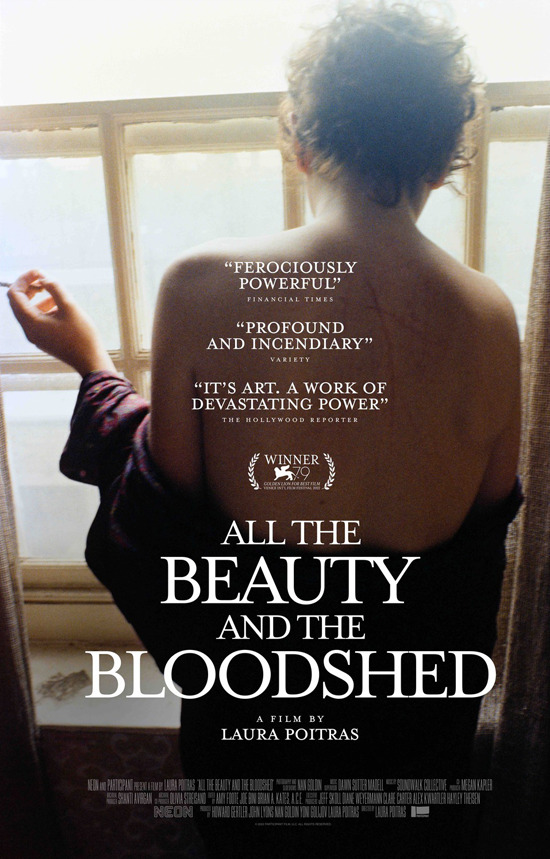
All the Beauty and the Bloodshed.
D: Laura Poitras (2022).
Addiction also drives Laura Poitras documentary portrait of photographer Nan Goldin, who ran away from a repressive dysfunctional family (after the suicide of her brilliant and beloved sister) and dove into the bohemian demimonde of Boston and New York chronicling the drug addicts, queers, drag queens, hookers, sex workers etc. of lower bohemia. As a photographer she smashed the difference between artist and subject showing the underground denizens as her makeshift family (and during the 80s and 90s AIDS crisis, the decimation of that family). The film tells her story but intercuts it with her current struggle against the drug corporation Purdue Pharma over their marketing of oxycontin which helped turn her into an opioid addict and nearly killed her. Her activism is focused on pressuring the most prestigious museums in the art world (many of which have hosted her work) to reject the endowments of the Sackler family, major art philanthropists who also control Purdue, as well as removing their names from museum exhibits. Poitras takes what could have been a messy mélange of themes and turns it into a strong depiction of an artist’s turn to activism. By the end when Goldin makes the Pharma board listen on Zoom to hours of testimony from victims of the opioid epidemic (you can see the blood drain from their face) the story seems to be one of a piece – the lifelong effort by the artist to make us look at the people who are supposed to be invisible and to see them.
#all the beauty and the bloodshed#laura poitras#nan goldin#sackler#purdue pharma#oxycontin#review#documentary#kevrock
12 notes
·
View notes
Text
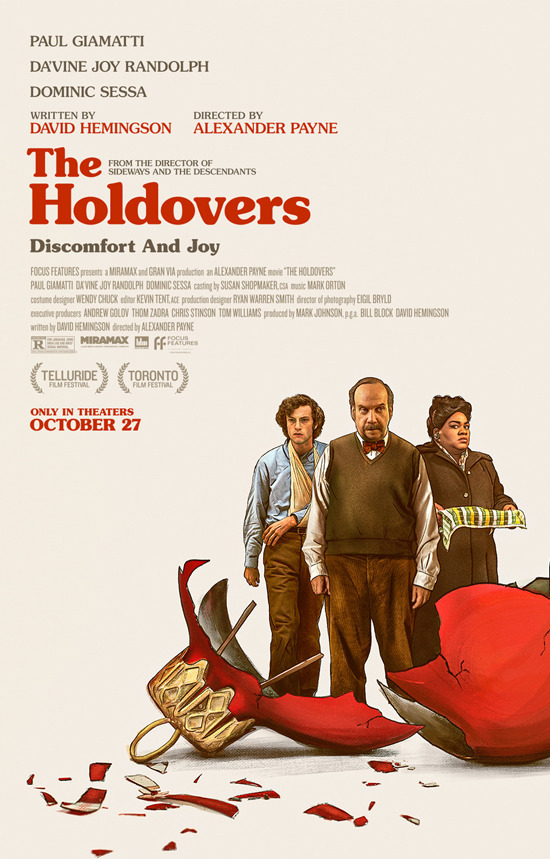
The Holdovers.
D: Alexander Payne (2023).
The Holdovers, set in a prestigious (though underfunded) New England prep school during the 1970 holiday break, is steeped in the grayish melancholy of washed out polaroids, which is completely appropriate for the story of three people having a miserable Christmas season. Paul Hunham (Paul Giamatti) an Ancient History teacher whose gleeful sarcasm towards his wealthy students (“I can’t fail this class” “Oh, don’t sell yourself short Mr. Kountz. I think you can”) barely conceals a bitterness towards his stalled life. After he flunks the son of a wealthy donor, he is given the punishment job of taking care of the holdovers – students left behind during the Christmas break. That includes Angus (Dominic Sessa), a smart rebellious kid who is effectively abandoned for the season by his mother and new stepfather and also misses out on the clumsy Deux ex Machina that rescues his fellow holdovers, leaving him alone with Hunham and Mary (Da’Vine Joy Randolph) the schools cafeteria manager who is mourning her son, an alumnus killed in Vietnam.
The script by David Hemingson sometimes has a predictable mustiness as the three bond in their misery, learn enough about each other to develop empathy and become better more compassionate people, but it is saved by the actors. Giamatti navigates Hunham from Mr. Chips to Scrooge turning a derivative construct into a human being. There’s nobody better at playing overeducated, articulate losers and this is his best since Payne’s Sideways. Sessa, in his first film role (he had only done High School theater) deftly balances the awkwardness of a precocious adolescent, alternating glib callowness and heartbreaking vulnerability especially in a revelation scene which in the wrong hands could easily have been trite. Randolph’s role is less developed but she gives an amazing performance, especially when she talks about the economic and racial circumstances that led her son to war instead of college (In 1970 failure to pursue higher education meant eligibility for the draft). She gives heft to a later scene where Hunham makes a sacrifice worthy of Dickens' Sidney Carton on behalf of Angus – without posturing, Giamatti shows us a man understanding some of what he has tried to teach his students and does it with dignity and grace. Much like this movie.
2 notes
·
View notes
Text

Blue Beetle.
D: Angel Manuel Soto (2023).
Jaime Reyes (Xolo Maridueña) isn’t the first Hispanic character to carry a superhero film – Miles Morales and Doctor Strange’s America Chavez were only the most recent to precede him --and a running joke in the film is the cheesy Mexican superhero comedy El Chapulin Colorado -- but it’s the first to proudly wear its ethnicity on its sleeve. That’s not always to the films credit. At times the story of a young Mexican-American graduate whose body fuses with a sentient alien weapon (in a sequence that mixes body horror and slapstick) placing him and his close family – wise parents (Elpidia Carrilloand Damián Alcázar) feisty younger sister (Belissa Escobedo), wacky uncle (George Lopez) and a grandmother (Adriana Barraza) who has…..a history – in danger, skirts Latino stereotypes a little too clumsily (Lopez especially lays on the schtick) and pushes the concept of familia almost too close to sentimentality. But when that same family is captured by armored goons (sent by Susan Sarandon’s entertainingly overplayed evil corporate head), lined up and forced to their knees the ICE parallels aren’t so much forced as simply obvious. At the same time the film’s embrace of pop culture junkiness (with a color scheme that evokes video arcades) keeps it from heavy-handedness. It might be the best Marvel movie DC ever made.
3 notes
·
View notes
Text

Paul Reubens
1952-2023
When Pee-wee’s Big Adventure (D: Tim Burton) came out in 1985 I’d already seen Pee-Wee Herman from the 1981 HBO special showcasing a heavily rouged child-man hosting a Midnight kids show for adults but the movie was still like nothing else I had ever seen. Paul Rubens who created the stunted naif wearing clothes he outgrew a decade ago, whose high-nasal voice barking laugh and repetitious taunts (“IknowyouarebutwhatamI INFINITY!”) were a loving tribute to childhood brattiness, had cleaned up his act just enough to encompass an innocence underlying the weirdness. He became beloved, hosting a real Saturday Morning kids show that won a slew of Emmys. He played the character to diminishing returns in Big Top Pee-wee and Netflix’s Pee-wee’s Big Holiday. He stepped away from the character occasionally, playing the Penguin’s father in Burton’s 1992 Batman Returns, a vampire in the bad movie version of Buffy the Vampire Slayer (1992), “The Spleen” in the superhero parody Mystery Men and a drug dealer in 2001’s Blow. Maybe it’s too bad he got typecast as Pee-wee (though I’ve never read or heard of any regrets on his part) but any time I think popular culture will never come up with anything new, he’s my go-to weirdo.
2 notes
·
View notes
Text
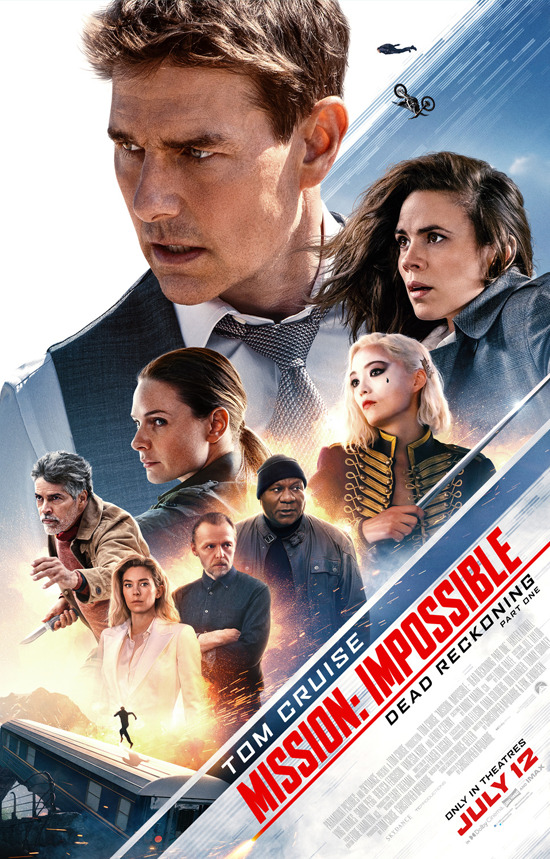
Mission Impossible: Dead Reckoning Part One.
D: Christopher McQuarrie (2023).
Good things first. The new Mission Impossible film delivers what it promises – almost nonstop action held together by an airplane novel plot that feigns complexity without taxing too many brain cells (It involves The Entity, a sentient AI program that’s intriguing -- maybe it wrote THE MOVIE THAT WE’RE SEEING – but comes across as one more garden variety villain). As IMF head Ethan Hunt, Tom Cruise is at his cocksure best and while the lore about him “doing his own stunts” is a little overblown (the film does have to be insured) it’s always fun to see how close he comes. As a professional thief hired to steal the key that can control or shut down the Entity, Haley Atwell holds the screen – if she doesn’t get to be the next Catwoman somebody is asleep at the switch – and as a gleeful assassin Pom Klementieff steals a car chase through Rome simply by having more fun than anyone else. (The male villains Esai Morales and Henry Czerny by contrast mostly glower) And the finale is something else, a involving a motorcycle jump over a mountain cliff, an incredibly tense duel of wits resolved by a preposterous rescue, and a runaway-train-meets-blown-up-bridge sequence in which Cruise and Atwell have to make it through a series of railway cars before they plunge into a ravine is both thrilling and hilarious demonstrating more than the recent Indiana Jones movie, the debt action movies owe to slapstick (a gag involving a piano might be a tip of the hat to Laurel and Hardy).
But all of this pales next to the most touching moment of the series after the death of a former operative, the remaining IMF team (Ving Rhames and Simon Pegg) talk about how hard it is for Ethan Hunt to lose his people and the camera switches to Cruise in close up trying to show grief and he…….can’t do it. Guy’s in his fifth decade as a superstar, multiple Oscar nomination and he still can’t summon anything like vulnerability to cross his big blank face. Doesn’t really mar the movie, but jeez.
4 notes
·
View notes
Text

Asteroid City.
D: Wes Anderson (2023).
Even for a Wes Anderson movie, Asteroid City is full of quotation marks. It’s about a convention of “Junior Stargazers,” (brainy teenagers) in a small desert town in 1950 (presented in a stylized cinematography we’ll call Retrocolor) whose claim to fame was being hit by a meteor. But the film is framed as a stage re-enactment penned by renowned playwright Conrad Earp (Edward Norton skewering theatrical pretension and slowly establishing an Edward Norton Type) which is itself refracted through a TV documentary about the play (both shown in vibrant black and white with Bryan Cranston channeling Rod Serling). The action of central film is centered on the budding relationship between a war photographer (Jason Schwartzman) who after two weeks has just told his children that their mother has died (“There never seemed to be a right time”), and a depressed movie star (Scarlett Johansson) that largely takes place in conversations between their adjoining cottage windows in a deadpan tone that makes Hal Hartley seem like Paddy Chayefsky. As usual Anderson assembles a large, overqualified cast (Steve Carell, Matt Dillon and Liev Schreiber have almost nothing to do) and stages everything with a studied, artificiality (featuring the prettiest and most controlled A-Bomb tests you’re likely to see this year).
But if this isn’t the director’s best movie (still Bottle Rocket) it’s his best since he became “Wes Anderson.” The distancing actually draws you into the world he creates and what it says about the tension between postwar optimism and post-nuclear anxiety that defined a certain point in history, and that history’s culture. And there’s a certain wonder in the director’s creation of a backwater town that’s suddenly populated by some of our most eccentric actors (seriously, where HAS Matt Dillon been?) and through a combination of an alien visitation and a government quarantine (neither of which is presented as a big deal) becomes a community for a time before being abandoned like a film set. At one point a cowboy (Rupert Friend) tells some school kids not to fear the alien (“No he ain’t American. No, he ain’t a creature of God’s Earth, but he’s a creature of somewhere.”) and Anderson extends this empathy to all of his characters who might be post-ironic conceptions but who flesh themselves out. They may act as though they know they’re in a play, but they are anyway. Asteroid City is a deadpan humanist masterpiece.
2 notes
·
View notes
Photo
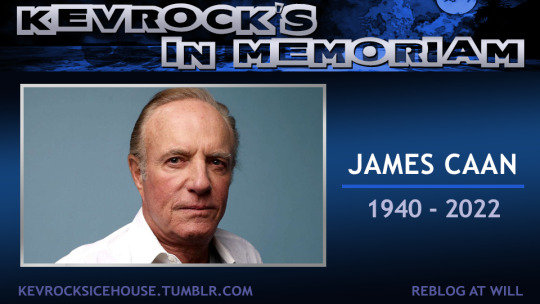
James Caan
(1940-2022)
In the early 90s I saw a TV Newsmagazine piece called “The Star and the Actor” which contrasted the careers of Arnold Schwarzenegger (fresh off the second Terminator) and James Caan (at the point where lead roles gave way to character ones). It was a shallow apples v. oranges piece but for all Caan’s wrong choices and bad breaks it was clear that he had by far the more interesting career in a more wide-open movie industry. Caan never completely lived up to his box-office potential. I can’t remember if he ever really opened up a movie. But he’ll always have Sonny.
As Santino, the hot-blooded horndog Don-by-default of the Corleone family, (left in charge after Vito was gunned down) Caan was the firecracker of The Godfather, giving the film a much-needed jolt of energy among the close-to-the-vest subtlety of Brando, Pacino and Duvall. Sonny was a man who carried every emotion and thought on his face all the time, and Caan brought a Cagney-like intensity to his scenes without a shred of ham and always allowing us to see that it was a weakness, not a strength. He was a precursor to Scorsese’s gangsters and his final scene was one of the greatest exits in film history.
Other than Sonny though, I bet your list of Caan movies is different than mine. He was Brian Piccolo in Brian’s Song (1971) the ultimate guy-weepie until Field of Dreams came along; Straight man among the eccentrics of Howard Zieff’s (and W. D. Richter’s) Slither (1973); As impresario Billy Rose, one of the few people not upstaged by Barbra Streisand in 1975’s Funny Lady; Clowning with Mel Brooks, Dom DeLuise and Marty Feldman without getting upstaged in Brooks’ Silent Movie (1976); Showing tremendous chemistry with both Angelica Huston and James Earl Jones in Coppola’s Vietnam reverie, Gardens of Stone (1987); Helping Kathy Bates win an Oscar in Rob Reiner’s 1990 Misery; A gambler trying to seduce Sarah Jessica Parker away from Nicolas Cage in Andrew Bergman’s screwball Honeymoon in Vegas (1992); As the most dark and nihilistic of the many criminals in Steve Klove’s Flesh and Bone (1993); Another small-time gangster in 1996’s Bottle Rocket (as the first big name in a Wes Anderson movie, you bet he helped to jump-start director’s career) and as one more mob boss avenging his daughter by bringing hell to Dogville in Lars von Trier’s 1993 morality fable. Just a fraction of his prodigious output, but not a dull or listless performance in the bunch. Never a movie star, always a good actor.
21 notes
·
View notes
Photo

Air.
D: Ben Affleck (2023).
The best thing about Air, the story of how Nike landed Michael Jordan as spokesman for what became the “Air Jordan” line of basketball shoes, is its lack of pomposity. There’s barely a whiff of a Great Moment in History or the Triumph of an Underdog. Instead, it’s the story of a wild hunch, and the many hurdles it takes to play it through, each more precarious than the last until faith is rewarded. It’s ultimately about the satisfaction of being right.
Of course, like so many nonfiction stories that satisfaction is a rigged game. At one point Nike talent scout Sonny Vaccaro (Matt Damon) makes the point that his certainty that third pick in the NBA, Michael Jordan will be the greatest player of all time is shared only with his mother Deloris (Viola Davis), and I couldn’t help but think “Yeah, and everybody who bought a ticket to the movie.” But Affleck (who plays Nike head Phil Knight as a visionary-flake) working off Alex Convery’s Aaron Sorkin-worthy screenplay, pulls off the kind of balancing act between suspense and inevitability that Ron Howard managed with Apollo 13 and Spielberg with Lincoln, highlighting the many ways the deal could have gone sideways. Nike was mostly a running shoe company, and had less money, clout and access than its rivals Converse and Adidas. Vaccaro had to sell an idea of putting Nike’s entire basketball promo budget behind one NBA rookie just to match the bigger boys. Damon wisely plays his insight not as an obsession than as a mental itch he can’t scratch (combined with a gambler’s love of playing a longshot) even as he has to convince his bosses (Jason Bateman alternating faith and dyspepsia), Jordan’s agent (a hilariously profane Chris Messina) and Deloris (whom Davis plays as a shrewd world-weary shark). Damon and Davis’s two scenes together are both an acting showcase for both the least and most theatrical great actors, and a nifty side-stepping of the film’s “So what?” problem (as to how an endorsement deal can be worth a whole movie). The importance of Jordan (played by Damian Delano Young as an untouchable icon in long shots with little dialogue) being a symbol of ADEQUATELY COMPENSATED greatness is put across not as self-interested cynicism so much as simple common sense. That the film closes with Affleck and Damon (who jump-started their careers with the longshot hit Good Will Hunting) sharing a congratulatory moment doesn’t seem gratuitous. They earned it.
4 notes
·
View notes
Photo
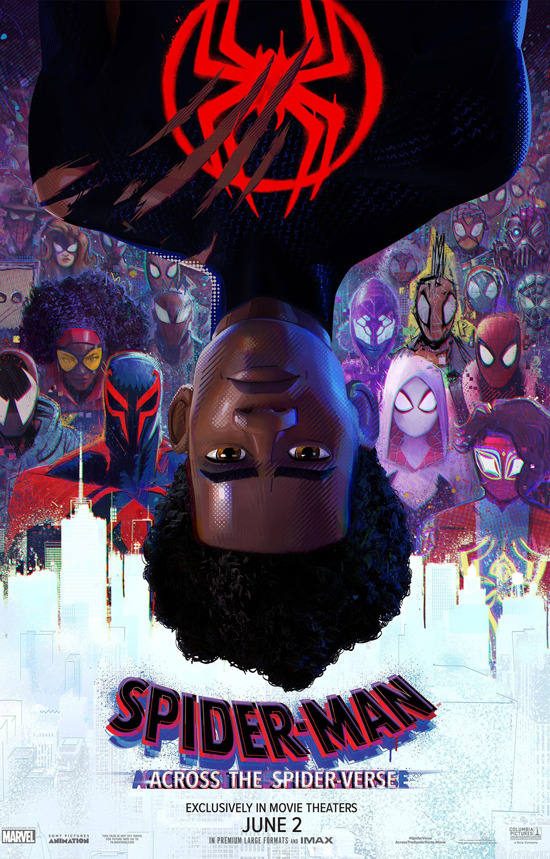
Spider-Man: Across the Spider-Verse.
D: Joaquim Dos Santos, Kemp Powers and Justin K Thompson (2023).
Spider-Man: Across the Spider-Verse opens with a gender switch on a classic Spider-Man trope. Gwen Stacy, (V. Hailee Steinfield) who fights crime as Spider-Woman while dodging the cops (including her police-captain father - v. Shea Wigham) who want her for the murder of her boyfriend Peter Parker (He became a super-villain and died fighting her as one does). On the night her father discovers her true identity things start to get weird. She encounters and then joins two alternate versions of Spidey: Miguel O’Hara (v. Jason Isaacs) and Jess Drew (v. Issa Rae) who lead a society of “variants” who patrol other dimensions and keep the many, many versions of the wall-crawler from going against “canon” and destroying their universes. Then after the opening credits the film blows up. In a good way.
When Gwen travels to the dimension of her old boyfriend Miles Morales (v. Shameik Moore) who we remember from the last Spider-Verse movie and they fight the dimension-hopping villain The Spot (v. Jason Schwartzman alternating psychosis and haplessness) the movie becomes a mash-up of Romeo and Juliet and Everything Everywhere All at Once as it’s creators blend a visual kaleidoscope of what seems like hundreds of animation styles (that amazingly don’t bump into each other) as well as a never-ending supply of Spidey-variants (Daniel Kaluuya as Spider-Punk and Karan Soni as an Indian Spider-Man stand out in the crowd) in a moving story about fate, free will, star-crossed lovers, power and responsibility (natch) that’ll touch your heart as your head spins. And then……..well if you can’t figure out what I’m not going to spoil, I’ll just say see this and I’ll see you in March.
2 notes
·
View notes
Photo

Guardians of the Galaxy Volume 3.
D: James Gunn (2023).
The secret surprise of James Gunn’s latest and last go-round with the dysfunctional gutter outlaws turned grungy cosmic superheroes, is the director’s heart. It was always there – the first two movies, in which a talking tree (v. Vin Diesel) that communicates by a million different inflections of “I am Groot”; Rocket (v. Bradley Coooper), a genetically modified raccoon mashup of Buck Rogers and Ratso Rizzo; team leader (and goofus savant) Peter “Star Lord” Quill (Chris Pratt), Gamora (Zoe Saldana) “the deadliest woman in the galaxy” (actually a time variant of the Gamora that was killed in the last Avengers saga who has no emotional connection to the team or her romance with Quill) and her sister Nebula (Karen Gillian) both children of galactic scourge Thanos; Drax (Dave Bautista) a super-strong warrior who alternates between dim-witted and other-witted; and Mantis (introduced in Vol. 2 and played by Pom Klementieff), Quill’s half-sister and empath: stumbled into becoming a team were a sterling “you make your own family” story disguised as it’s opposite. But Gunn’s ability to evoke pathos even while making fun of it is both fine-tuned and amped up. At his best he suggests Steven Spielberg as a Farrelly brother.
The movie feels clunky and overstuffed at first, as Gunn tries to juggle all of these characters and more but after Rocket is seriously injured in a kidnapping attempt masterminded by The High Evolutionary (the mad geneticist who created him played with cruel savagery by Chukwudi Iwuji) and the team has to find the computer code that can save him, the film finds it’s footing, alternating a race-against-time rescue quest with flashbacks to Rocket’s origin that Gunn turns into a grim fairy tale of young animals trying to survive a life defined by sadistic experimentation. The flashbacks give both the characters and the story a new emotional depth that colors the action and laughs (which are abundant). This is almost certainly Gunn’s last Marvel movie for some time and it’s a little poignant that he’s ending the franchise on such a high note. The dysfunctional clowns self-appointed to protect the cosmos will leave you with a smile on your face and a tear in your eye.
4 notes
·
View notes